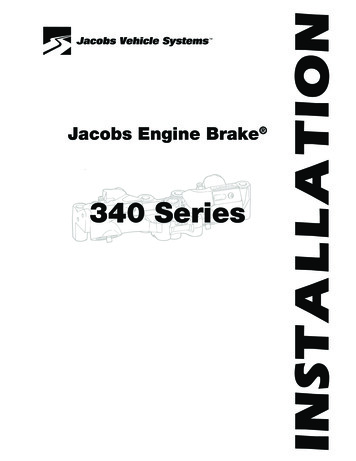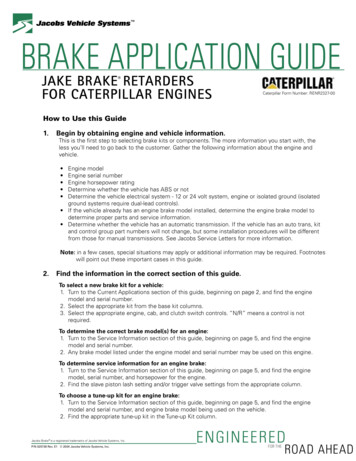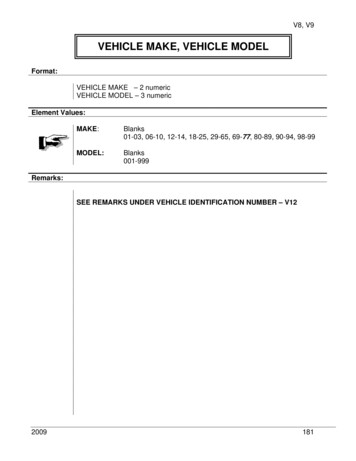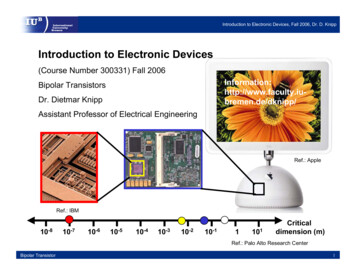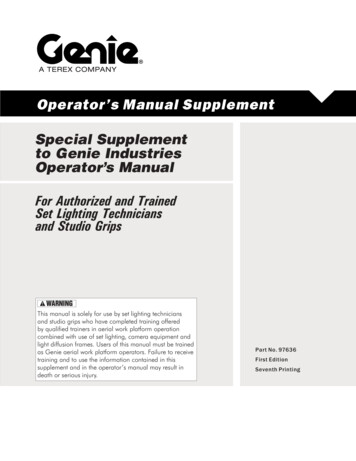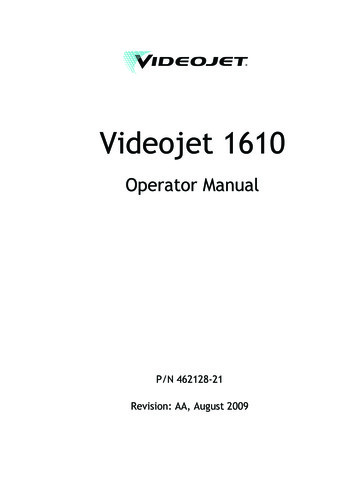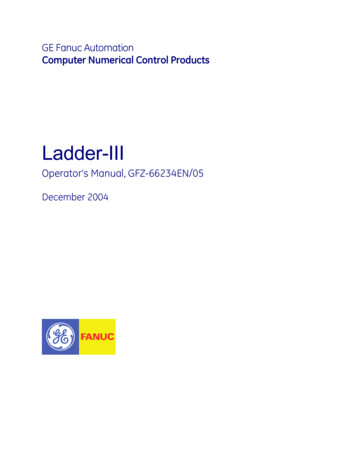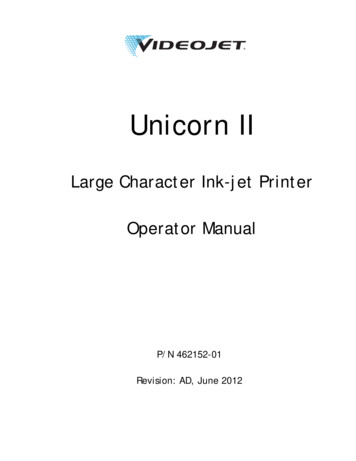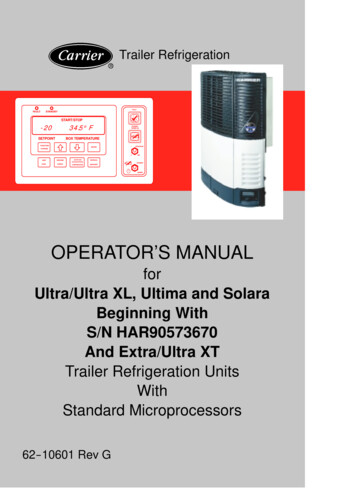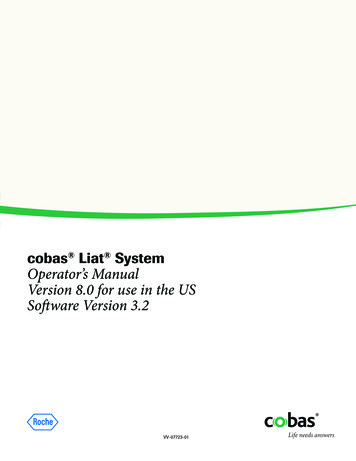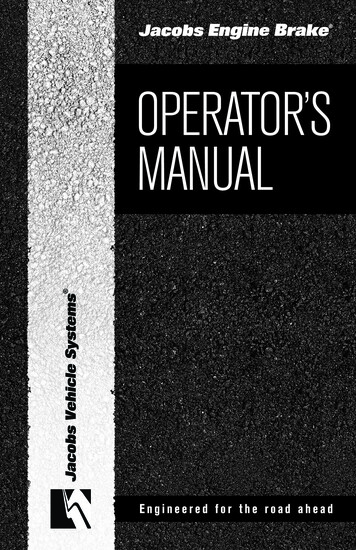
Transcription
OPERATOR’SMANUALEngineered for the road ahead
ContentsIntroduction.2Safety Precautions.2Using Your Jacobs Engine Brake .3Driver Controls.3Engine Controls.4Jacobs Engine Brake Operation.4ABS (Anti-Lock Braking System).5Automatic Transmissions/Automatic Manual.5Cruise Control.6Driving with Your Jacobs Engine Brake.7Flat, Dry Pavement.7Descending a Grade.8Slippery Pavement.10Maintenance and Service.12Recommended Preventative Maintenance Schedule.12Warranty Coverage and Procedures.14For More Information.14Operator’s Manual1
IntroductionCongratulations! Your vehicle is equipped with the genuine JacobsEngine Brake . The Jacobs Engine Brake (also known as the “JakeBrake ”) is widely recognized throughout the trucking industry forits quality, reliability, and performance. This manual contains usefulinformation on the operation and maintenance of your Jacobs EngineBrake. Read this manual thoroughly and fully understand the enginebrake system before you drive your Jacobs Engine Brake-equippedvehicle.The Jacobs Engine Brake is a diesel engine retarder that uses theengine to aid in slowing and controlling the vehicle. When activated,the engine brake alters the operation of the engine’s exhaust valvesso that the engine works as a power-absorbing air compressor. Thisprovides a retarding, or slowing, action to the vehicle’s drive wheels,enabling you to have improved vehicle control without using theservice brakes. This conservation results in reduced service brakemaintenance, shorter trip times, and lower total cost of ownership.Safety PrecautionsThe following symbols in this manual signal conditions potentiallydangerous to the mechanic or equipment. Be aware that theseconditions can exist, then take the necessary steps to protectpersonnel as well as equipment.Statements marked with this symbol indicate potentially dangerousconditions including the possibility of personal injury.!CAUTIONStatements marked with this symbol are important for the safe use andcare of the Jacobs Engine Brake.Statements marked with this symbol indicate an operation, procedureor instruction that is important for correct service.Please refer to the operator’s manual provided by the manufacturer of yourvehicle for additional information and operations that may differ from thosedescribed in this manual.Jacobs Engine Brake 2
Using Your Jacobs Engine BrakeThe Jacobs Engine Brake is a vehicle-slowing device, not a vehiclestopping device. It is not a substitute for the service braking system.The vehicle’s service brakes must be used to bring the vehicle to acomplete stop. However, by appropriately using the engine brake foryour slowing needs, the service brakes will remain cool and ready toprovide their maximum stopping power when needed.Driver ControlsIt is important to familiarize yourself with the Jacobs Engine Brakecontrols in your vehicle. As discussed below, the controls will varyslightly depending on the engine brake configuration and cab design.However, basic operator controls will be similar for all models. Allvehicles with manual transmissions (for automatic or automaticmanual transmissions, refer to Pg. 5) will allow the driver to turnthe engine brake on and off and select the desired level of braking.Below are illustrations of the types of switches that you may find inyour vehicle.Note: Switches supplied by Jacobs Vehicle Systems may be different from theones installed in your vehicle by the vehicle manufacturer (physical appearancevaries but function should not).Low/High Switch: The “Low” setting providesapproximately half of the braking horsepower.The “high” setting provides full brakinghorsepower.Low/Med/High Switch: The “Low” setting providesapproximately one-third of the total brakinghorsepower. When the “Medium” setting isselected, approximately two-thirds brakinghorsepower will activate. The “High” setting willactivate, providing full braking horsepower.Other configurations besides the dash switchmay be offered to give you control of the on/offfunction of the Jacobs Engine Brake. Optionsmay include a foot-operated pedal, a steeringwheel mount, or a shift lever switch.Operator’s Manual3
Engine ControlsAll Jacobs Engine Brakes have two additional controls: one activatedby the position of the clutch pedal, and the other by the position ofthe throttle. The two controls can provide for fully automatic operationof the Jacobs Engine Brake.On vehicles equipped with electronic engine controls, the controlswill deactivate the engine brake when engine speed falls belowapproximately 1000 rpm or when the vehicle slows down to apre-set speed. This will vary depending on the vehicle and engineconfiguration and is intended to prevent the engine from stalling.On vehicles equipped with mechanical engine controls and manualtransmissions, depress the clutch pedal at low speeds to prevent theengine from stalling. Alternatively, a low-speed cutoff control may beinstalled to ensure deactivation of the engine brake at low vehiclespeeds.Jacobs Engine Brake Operation!CAUTIONThe Jacobs Engine Brake depends on the free flow of engine oil foroperation, so be sure to let the engine reach a minimum operatingtemperature of 40 C/104 F before switching on the engine brake.Normally, the engine brake is then left in the “On” position wheneveryou are driving. The exception is when roads are slippery due to poorweather conditions. Refer to Pg. 10 for specific operating instructions.The operation of the Jacobs Engine Brake isfully automatic once turned on. When yourfoot is off the clutch and your foot is completelyremoved from the throttle, the engine brakewill automatically activate. (There are somesystems that will activate only once the brakepedal is depressed.)When you apply pressure to the throttle, theJacobs Engine Brake is deactivated.Jacobs Engine Brake 4
While shifting gears, the engine brake isautomatically deactivated when you depressthe clutch pedal.Note: The Jacobs Engine Brake will also remainactivated after the brake pedal has been depressed,giving the combined power of both the engine brakeand the service brakes to the drive wheels as longas the clutch is not depressed at the same time.ABS (Anti-Lock Braking System)Vehicles equipped with ABS have the ability to turn the enginebrake off should a wheel slip condition occur. The engine brakewill automatically be turned back on when a wheel slip is no longerdetected.!CAUTIONBe sure to turn off the engine brake switch when you shut the enginedown. This will prevent the switch from being in the “on” position atengine cold start.Automatic TransmissionsIf you have an automatic or automatic manual transmission, operationof the Jacobs Engine Brake functions essentially in the same manneras vehicles with manual transmissions. The engine brake is activatedwhen you move your foot off the throttle and deactivated when youapply pressure to the throttle. A pressure-sensing switch (or theelectronic engine controls) will deactivate the Jake Brake when theengine speed falls below approximately 1000 rpm, or when thevehicle slows down to a pre-set speed. It may also occur when thetransmission shifts from lock-up to converter operation (usually about10-25 mph or 16-40 km/h, depending on the transmission type).NOTE: With “Autoshift” type transmissions, the engine brake may actuate to helpthe transmission upshift. This is done automatically through the transmissioncontrol module and can happen even if the engine brake switch is in the “off”position.Operator’s Manual5
Cruise ControlThere are several types of cruise control systems, and the operationof the Jacobs Engine Brake in those vehicles will depend on theengine and options provided by the vehicle manufacturer. Somecruise controls are specifically designed to operate in conjunctionwith the Jacobs Engine Brake. It may be possible to programactivation of the engine brake during cruise control operation. Whenenabled, the system activates the engine brake when the vehicleexceeds the cruise control set speed. The engine brake will operateuntil the vehicle has slowed to 1/2 mph or 1/2 km/h above cruisecontrol set speed. Refer to the vehicle’s operator’s manual foradditional information as this may vary by make and model.Jacobs Engine Brake 6
Driving with Your Jacobs Engine BrakeSince the engine brake is most effective at higher engine speeds,gear selection is very important. To obtain maximum retardingpower, use the lowest possible gear without exceedingthe recommended engine speed for engine braking. Bestretarding performance is obtained at engine speeds between2100 rpm and high idle. Below 1700 rpm, retarding power may besignificantly reduced.Braking HorsepowerBraking Horsepower vs. Engine RPMEngine RPMThe Jacobs Engine Brake master switch must be turned on in orderto operate. Once turned on, release the clutch pedal and removeyour foot from the throttle. The Jacobs Engine Brake will thenactivate, providing retarding power to the vehicle. Apply the servicebrakes when it is time to come to a complete stop.Flat, Dry PavementIf you are driving on flat, open stretches witha light load and greater slowing power is notrequired, place the progressive braking switchin the “Low” position. If you find that you arestill using the service brakes, move the switchto a higher position until you have the desiredJake Brake retarding power.Operator’s Manual7
When you are carrying a heavier load ordescending a grade and the pavement is dryand traction is good, your progressive brakingswitch should be in the “High” position.Descending a GradeBefore beginning a long, steep descent, determine if yourJacobs Engine Brake is operating properly. This can be doneby lifting your foot briefly off the throttle. You will feel theJacobs Engine Brake activate.An explanation of “control speed” is helpful in understanding howto use the Jacobs Engine Brake while descending a grade. Controlspeed is the constant speed at which the forces pushing the vehicleforward on a grade are equal to the forces holding it back. Or in otherwords, the speed the vehicle will maintain without using the servicebrakes or the throttle.Note: The following road speeds and grades are given as examples only! Actualconditions and engine braking performance will vary.Depending on road and loadconditions, you may be able todescend a 6% grade safely at10 mph or 16 km/h by usingthe service brakes alone.Jacobs Engine Brake 8
With the Jacobs Engine Brake setto the “High” position, you mightbe able to descend that samegrade at 45 mph or 72 km/h andstill remain under control withoutusing your service brakes. Theengine brake can be kept on foras long as needed without anyrisk of engine overheating ordamage.Note: There are several variables that apply to a controlled speed, includingbut not limited to: rolling resistance, air resistance, and grade.Under some circumstances, you may want to come down a grade ata faster rate than the control speed. This can be done by selectinga higher gear or a lower position on the progressive braking switch.However, you may have to apply your service brakes intermittently toprevent over-speeding of the engine and to keep the vehicle at a safespeed.Frequent use of the service brakes will cause them to heat up,reducing their stopping ability. This can result in dangerousbrake fade.There may be circumstances in which you might want to descenda grade at a rate slower than the control speed. This is done byselecting a lower gear, one that will not over-speed the engine. Youmay toggle between the different brake retarding levels to increase ordecrease your road speed as desired.Like any product, the Jacobs Engine Brake can be abused. Forinstance, the above example of the 6% grade, which you coulddescend under control only at 10 mph or 16 km/h without an enginebrake but at 45 mph or 72 km/h with an engine brake. You couldnot descend that same hill at 65 mph or 104 km/h and still expectto remain under control. Get to know how much slowing power yourengine brake can provide. Never exceed a safe control speed.Operator’s Manual9
Slippery PavementSince the operation of any vehicle under slippery conditions isunpredictable, be sure that you have plenty of stopping distancebefore testing your service brakes or Jacobs Engine Brake.The operation of the ABS (Anti-lock Braking System) will not beaffected by the operation of The Jacobs Engine Brake. The ABSsystems should deactivate the engine brake when a wheel slipoccurs and traction is lost, and will reactivate the engine brake whenthe ABS system has disengaged.I
manual transmissions, refer to Pg. 5) will allow the driver to turn the engine brake on and off and select the desired level of braking. Below are illustrations of the types of switches that you may find in your vehicle. Note: Switches supplied by Jacobs Vehicle Systems may be different from the ones installed in your vehicle by the vehicle manufacturer (physical appearance varies but function .
